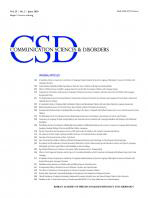- 영문명
- Early Vocalizations as Predictors of Later Language Development in Preterm Infants: A Longitudinal Study from 12 to 24 Months
- 발행기관
- 한국언어청각임상학회
- 저자명
- 박보라(Bo Ra Park) 박성종(Sung Jong Park) 고은재(Eun Jae Ko) 홍새미(Sae Mi Hong)
- 간행물 정보
- 『Communication Sciences & Disorders』vol30. no.3, 413~424쪽, 전체 12쪽
- 주제분류
- 사회과학 > 교육학
- 파일형태
- 발행일자
- 2025.09.30

국문 초록
배경 및 목적: 미숙아는 만삭아에 비해 언어 지연 위험이 높아 조기 발견이 필수적이다. 본 연구는 미숙아의 12개월 발성이 24개월 언어 능력에 미치는 영향을 살펴보고, 초기 발성이 이후 언어 발달을 예측하는 데 유용한지 확인하고자 하였다. 방법: 미숙아 31명을 대상으로 12개월과 24개월 시점에서 종단적으로 자료를 수집하였다. 12개월에는 보호자 면담 도구를 사용해 발성 능력을 평가하고, 전음절성, 음절성, 낱말 단계별로 백분율 점수를 산출하였다. 24개월에는 표준화된 언어 평가를 통해 수용 및 표현언어지수를 산출하였다. 결과: 12개월 시점에서 전음절성 발성 점수가 가장 높았으며, 음절성 및 낱말 단계 점수는 상대적으로 낮았다. 음절성 발성 점수는 24개월 수용 및 표현 언어지수와 관련을 보였으며, 전음절성 발성은 이후 언어 능력과 관련이 없었다. 또한 12개월 음절성 발성 점수는 24개월 표현언어 능력을 유의하게 예측하였으나, 음절성 발성 세부 항목들은 개별적으로는 유의한 예측력을 보이지 않았다. 논의 및 결론: 미숙아의 12개월 음절성 발성은 이후 표현언어 발달과 밀접한 관련이 있는 것으로 나타났다. 이는 초기 발성 능력이 미숙아의 언어 발달문제를 조기에 선별하는 데 유용한 지표가 될 수 있음을 시사한다.
영문 초록
Objectives: Preterm infants are at increased risk for delayed language development. This study aimed to investigate the impact of vocalization at 12 months on language abilities at 24 months in preterm infants and to assess whether early vocalization can serve as a predictor of later language outcomes. Methods: A longitudinal study was conducted with 31 preterm infants assessed at 12 and 24 months. At 12 months, vocalizations were evaluated via a caregiver interview tool and categorized into precanonical, canonical, and word stages, with percentage scores calculated for each. At 24 months, receptive and expressive language quotients were measured using standardized assessments. Results: Preterm infants demonstrated the highest scores in the precanonical stage at 12 months, with lower scores in the canonical and word stages. The canonical vocalization scores at 12 months were significantly correlated with receptive and expressive language quotients at 24 months, while precanonical vocalizations showed no significant correlations. Additionally, canonical vocalization scores significantly predicted expressive language abilities at 24 months. However, subcomponents of the canonical stage did not individually predict language outcomes. Conclusion: Canonical vocalization at 12 months is closely associated with expressive language development at 24 months in preterm infants. Early assessment of vocalization may be a useful tool for identifying infants at risk for language delays, enabling timely intervention.
목차
연구방법
연구결과
논의 및 결론
REFERENCES
해당간행물 수록 논문
참고문헌
최근 이용한 논문
교보eBook 첫 방문을 환영 합니다!

신규가입 혜택 지급이 완료 되었습니다.
바로 사용 가능한 교보e캐시 1,000원 (유효기간 7일)
지금 바로 교보eBook의 다양한 콘텐츠를 이용해 보세요!


